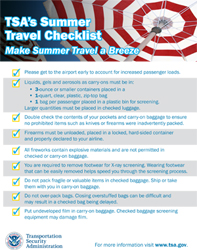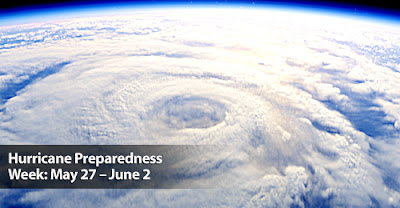There
are a few new things to talk about this summer. The TSA Contact Center has
extended their hours, and we’ve modified screening procedures for low-risk
passengers. Also, TSA Pre✓™ continues to grow with more airports and
airlines coming on board. Read on to learn more about what’s new with TSA and
also pick up a few travel tips along the way.
How to
Avoid Additional Screening: The most important tip to help you avoid a
pat-down is to take everything out of your pockets before screening and put items
in your carry-on bag. Don't wear clothes with a high metal content, and put
heavy jewelry on after you go through security. If you have a hidden
medical device (insulin pump, ostomy bag, brace, etc.), please let the officer
know.
 TSA Pre✓™ Expedited Screening: TSA
Pre✓™ continues to grow,
providing expedited screening to eligible passengers at 15 airports, with plans
to expand to more airports and airlines throughout 2012. If you’ve been
contacted by your participating airline or if you’re a current member of one of
CBP’s Trusted Traveler programs (Global Entry, NEXUS or SENTRI), be sure to opt
in. If you would like to participate, click here and follow the simple
directions to apply to become eligible for expedited screening. Click here to learn more
about where TSA Pre✓™ is and where it’s coming to.
TSA Pre✓™ Expedited Screening: TSA
Pre✓™ continues to grow,
providing expedited screening to eligible passengers at 15 airports, with plans
to expand to more airports and airlines throughout 2012. If you’ve been
contacted by your participating airline or if you’re a current member of one of
CBP’s Trusted Traveler programs (Global Entry, NEXUS or SENTRI), be sure to opt
in. If you would like to participate, click here and follow the simple
directions to apply to become eligible for expedited screening. Click here to learn more
about where TSA Pre✓™ is and where it’s coming to.
Other
Risk Based Security Initiatives: Since last fall, TSA has
implemented modified screening procedures for passengers 12
and younger. Passengers 12 and younger can now leave their shoes on during
security screening. These new screening procedures also include permitting an
additional pass through advanced imaging technology to clear any alarms, as
well as greater use of explosives trace detection.
Additionally,
TSA recently concluded a modified screening pilot program for passengers ages
75 and older. As the program proceeds toward full implementation, passengers 75
and older will undergo similar modified screening procedures to those 12 and
under and will be able to leave on a light jacket or outwear when passing
through security. Passengers 75 and older may see these procedures in place as
they travel this summer.
TSA
Contact Center:
The Contact Center hours were recently extended and a representative is now
available Monday – Friday, 8 a.m. – 11 p.m. Eastern time; weekends and federal
holidays, 9 a.m. – 8 p.m. Eastern time. The TCC can be reached at 866-289-9673.
Passengers can also reach out to the TSA Contact Center (TCC) with
questions about TSA procedures, upcoming travel or to provide feedback or voice
concerns.
TSA
Cares Helpline:
Travelers or families of passengers with disabilities and medical conditions
may call the TSA
Cares helpline toll free 855-787-2227, 72 hours prior to traveling with any
questions about screening policies, procedures and what to expect at the
security checkpoint. A TSA Cares helpline representative is available during
all TSA Contact Center hours.
The
MyTSA App: Want TSA
information anywhere, anytime? Use the MyTSA
app. Among the great features, there’s a “Can I Bring My…” tool. Type in
the name of the item you’re curious about and it tells you if the item is
permitted or not, along with packing tips. Wondering if you can take your bug
repellant on the plane? Check the app
to find out. A wait time feature is also available. It relies on crowd sourcing which
means the more people who use it, the better.
The
4-1-1 on 3-1-1 (Liquids, Gels & Aerosols): If you’re checking a bag,
make things simple by packing liquids in your checked luggage. That way, you
don’t have to worry about the 3-1-1 liquids rules. (If you’re concerned
about them leaking, do what I do and put them in a zip-top bag.) But I
know that doesn’t work for everyone; either your trip is a short one or you’re
only bringing a carry-on bag. If you have to take liquids in your carry-on,
please continue reading… 3-1-1 is a quick way to remember how our liquids
policy works. You can read here for more details, but here is the gist: each passenger
is allowed to take as many 3.4 ounce or less sized containers that will
fit in one sealed clear quart-sized zip-top bag – and one bag per
person. Make sure you take the zip-top bag out of your carry-on
prior to sending it through the X-ray.
Here is
some information on frequently asked liquid, aerosol and gel items:
- Suntan & Sun Block Lotion: Lotions fall under the 3-1-1 procedures that I mentioned above. So do the aerosol spray lotions. Sun block sticks do not fall under this rule.
- Makeup: Any liquid makeup cosmetics such as eyeliner, nail polish, liquid foundation, etc. should be placed in the baggie. That goes for perfume as well. Powder makeup is fine.
- Beverages: Wine, liquor, beer, and all of your favorite beverages are permitted in your checked baggage. You can also bring beverages packaged in 3.4 oz or less bottles in your carry-on bags in the 3-1-1 baggie.
Sporting
Goods: Golf
clubs, baseball bats (including the mini slugger bats), cricket bats, bows and
arrows, hockey sticks, scuba knives, spear guns, etc. are all prohibited from
being carried onto the plane. However, you
can have put them in your checked bag.
Destination
Weddings: Getting
married soon? We’ve been asked about it a lot lately on our MyTSA
app, so we wrote a post on it. Be sure to check it out
for some great tips.
Camping,
Hunting, or Fishing?: If
you’re heading to the great outdoors, be sure to check
out this post for tips on traveling with camping, hunting, and fishing
gear.
Double
Check Your Bag for Guns: Seriously!!!
It sounds silly, but if you read our Week in Review
posts, you’ll see that our officers find at least two guns every day at
checkpoints in the U.S. A good percentage of those were loaded. The most
common excuse is that the passenger didn’t know it was there or forgot it was
in the bag. Save yourself the hassle of a bag check, a police interview and a
potential arrest by making sure you leave your gun at home.
Shaving
Razors: You can
get more info from our blog post on this subject where the pictures will answer
all of your questions.
Lost or
Forgotten IDs: We’ve
gotten many calls from people who’ve had a wallet stolen or lost on a trip and
have no ID for their return trip. Don’t worry, if this happens to you,
you’ll still be permitted to fly as long as you help us verify you are
who you say you are by answering a few questions. It’s wise to get to the
airport a little earlier just to be safe.
If you’d like to comment on an unrelated topic you can do so in our Off Topic Comments post. You can also view our blog post archives or search our blog to find a related topic to comment in. If you have a travel related issue or question that needs an immediate answer, you can contact a Customer Support Manager at the airport you traveled, or will be traveling through by using Talk to TSA.


